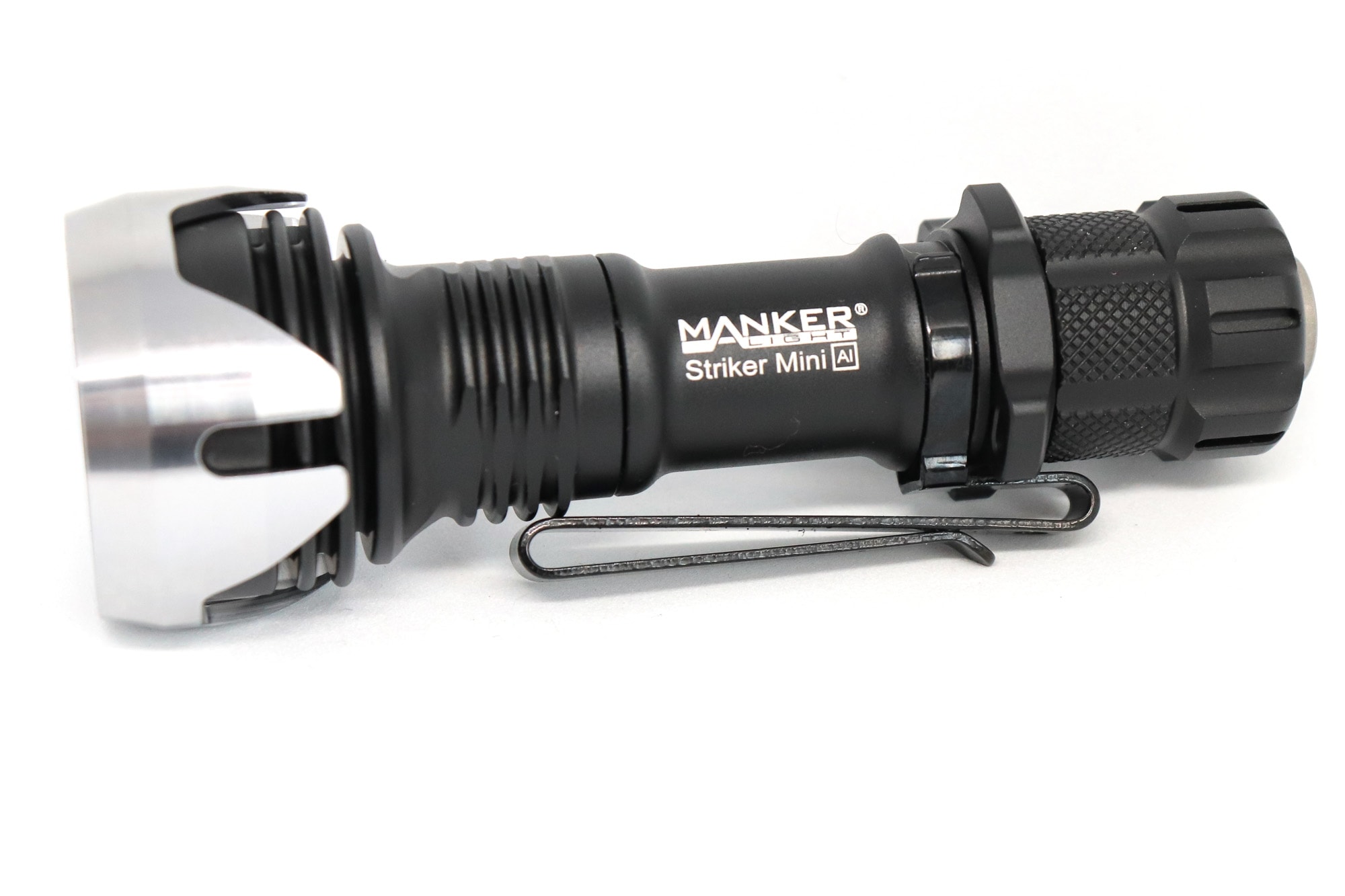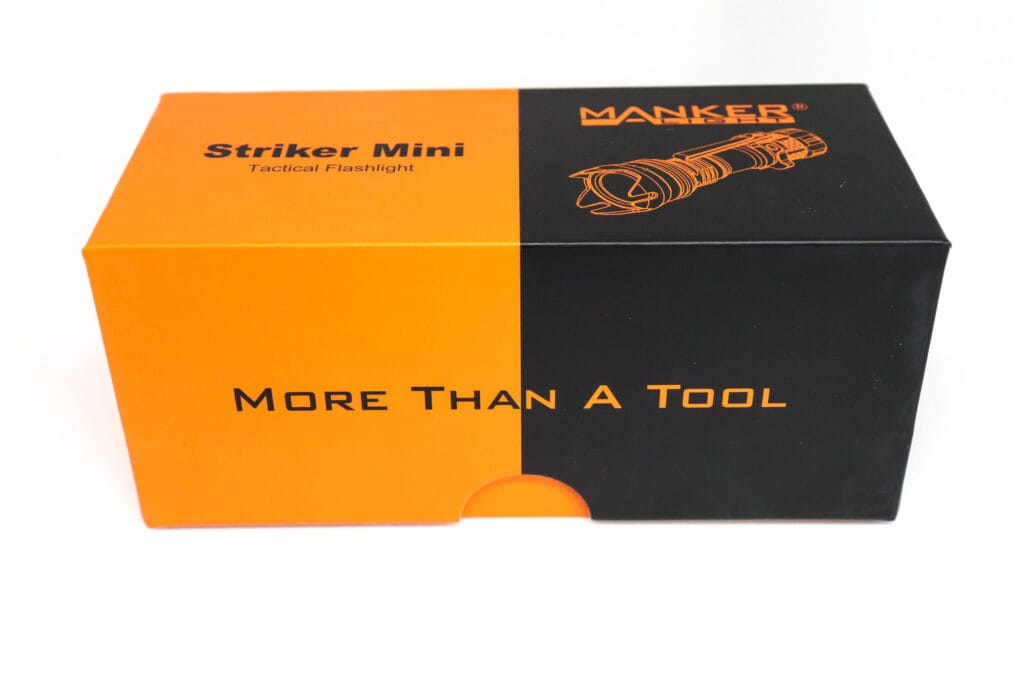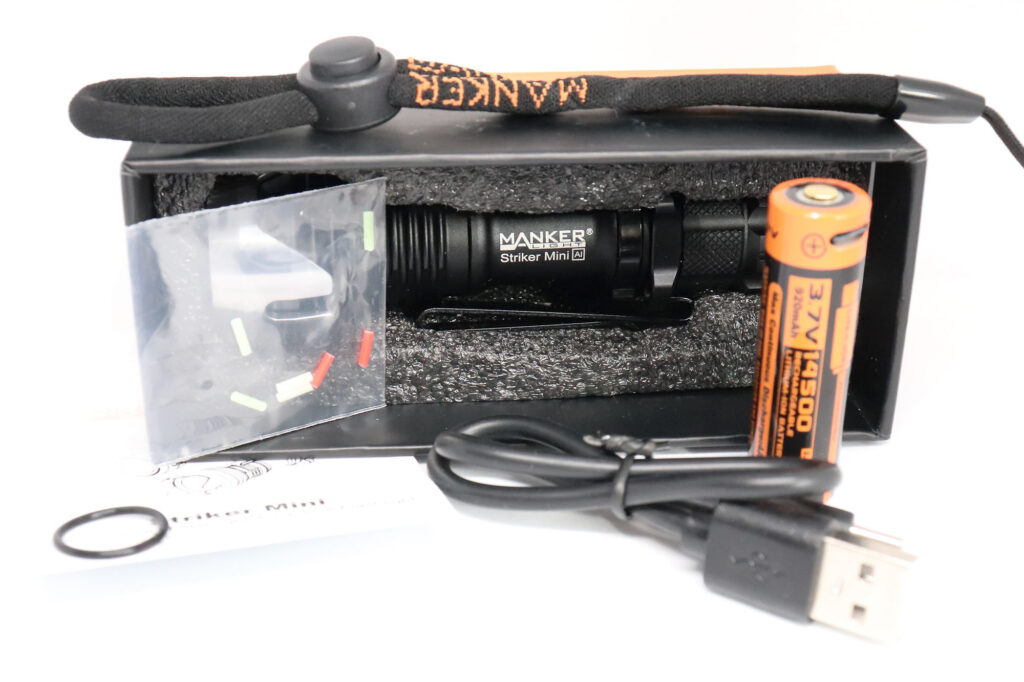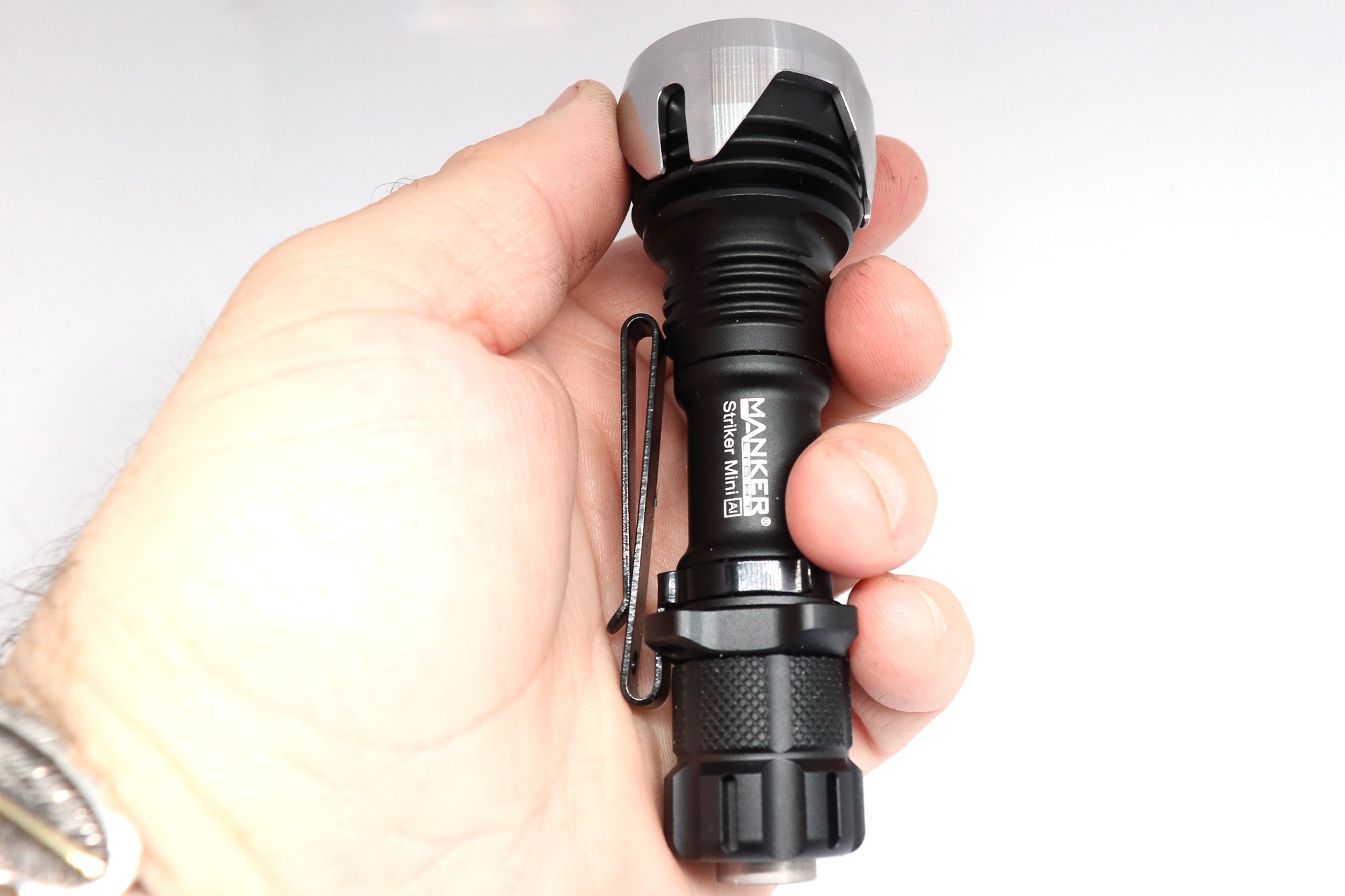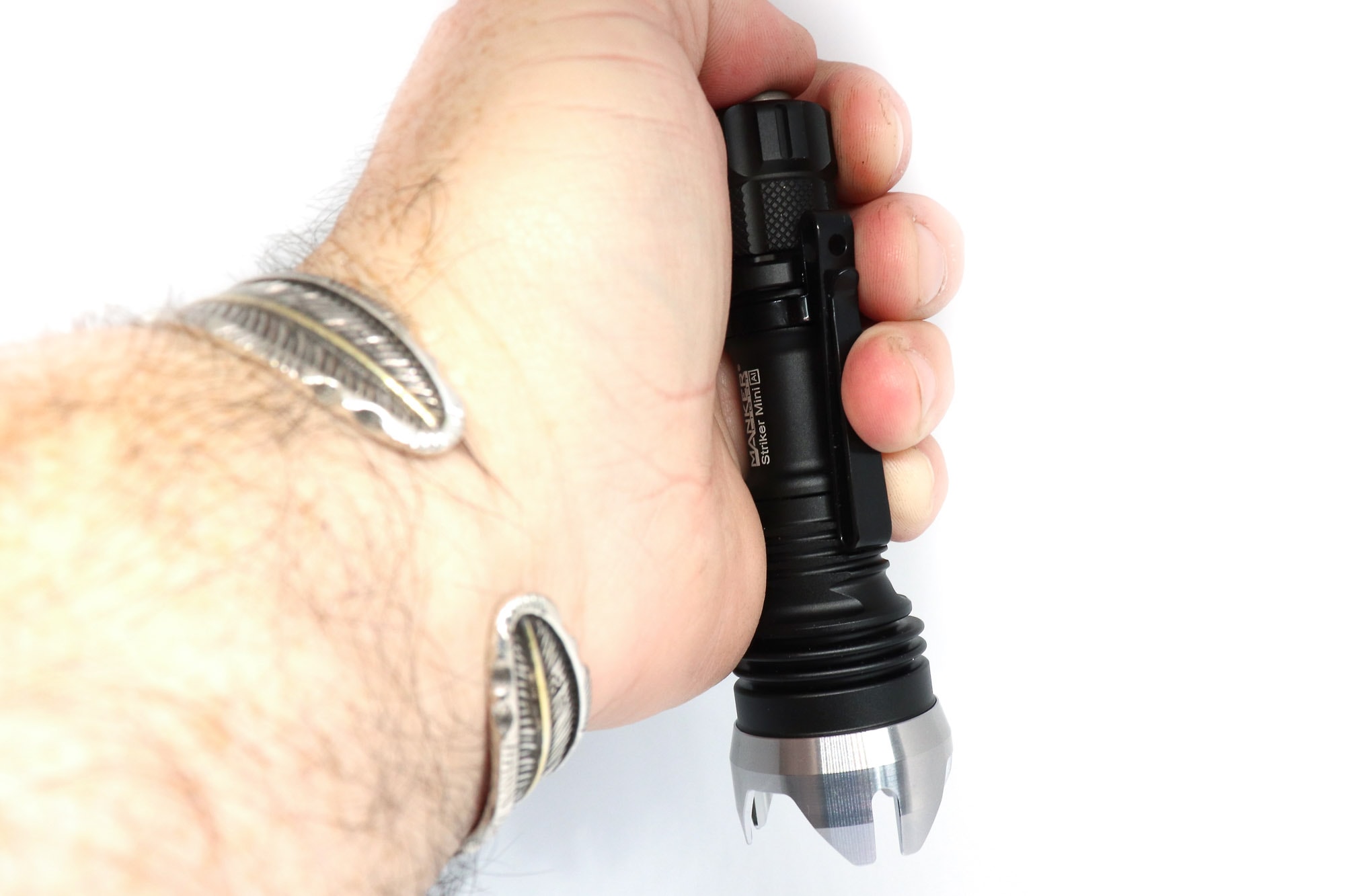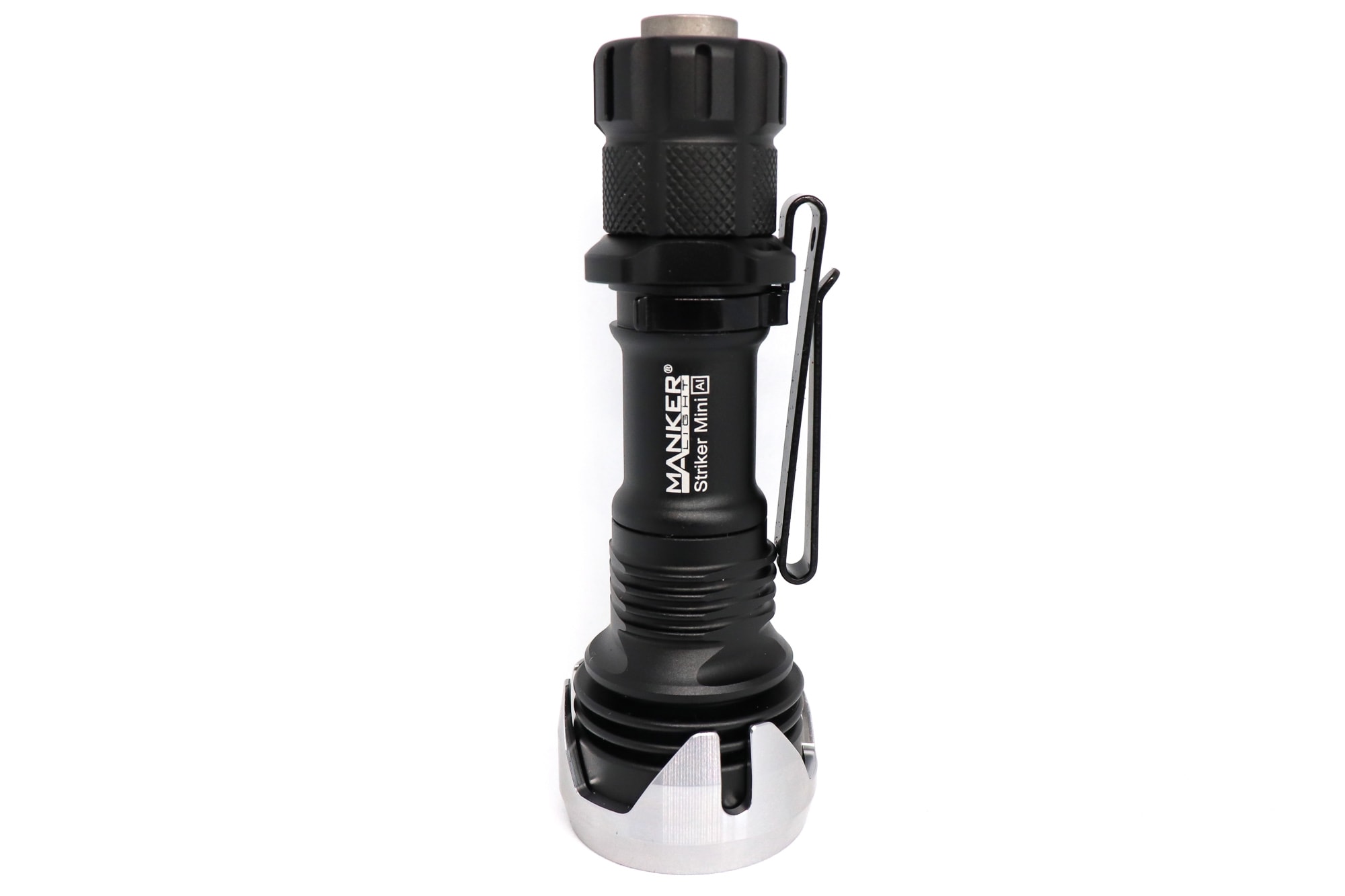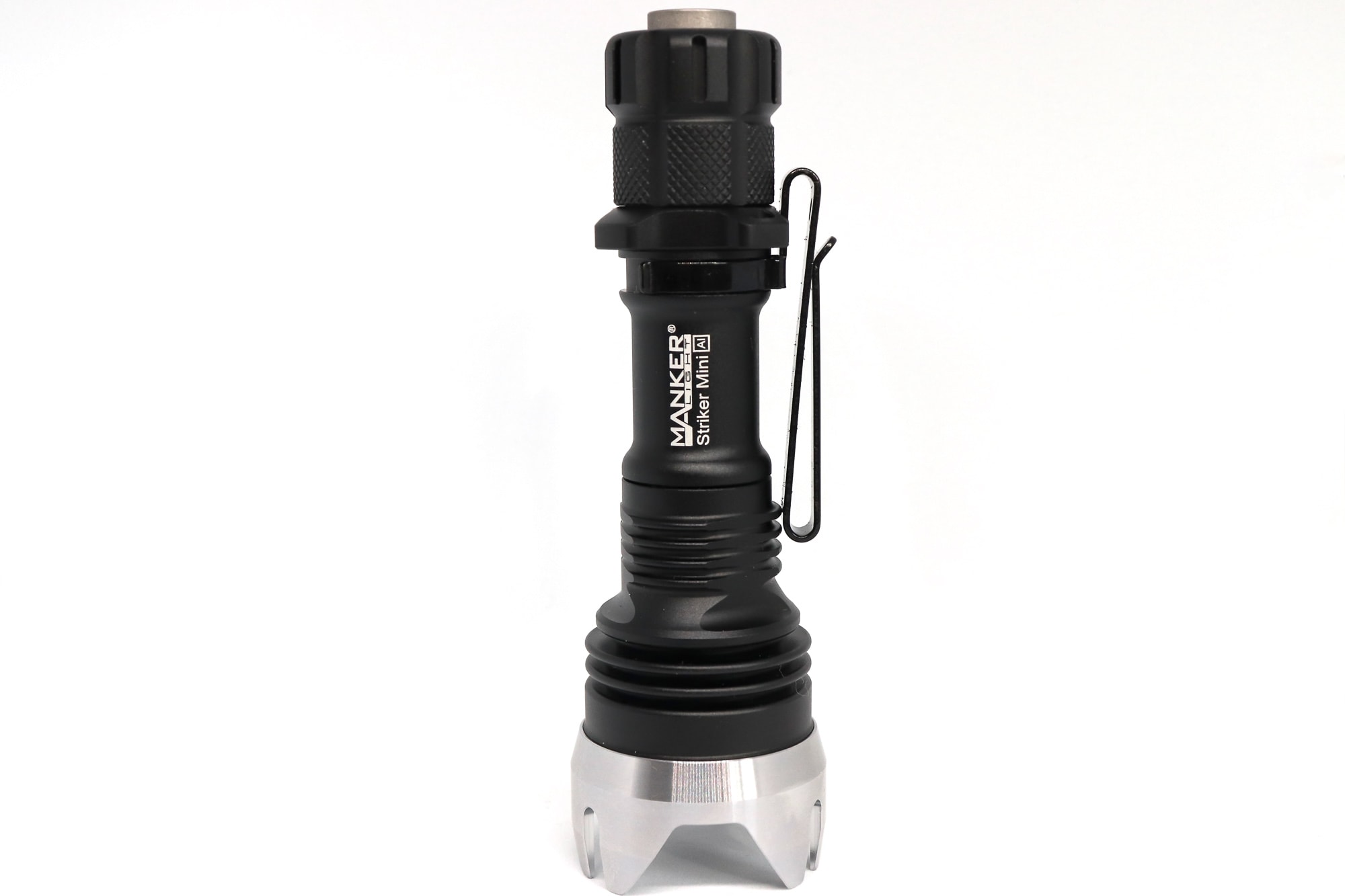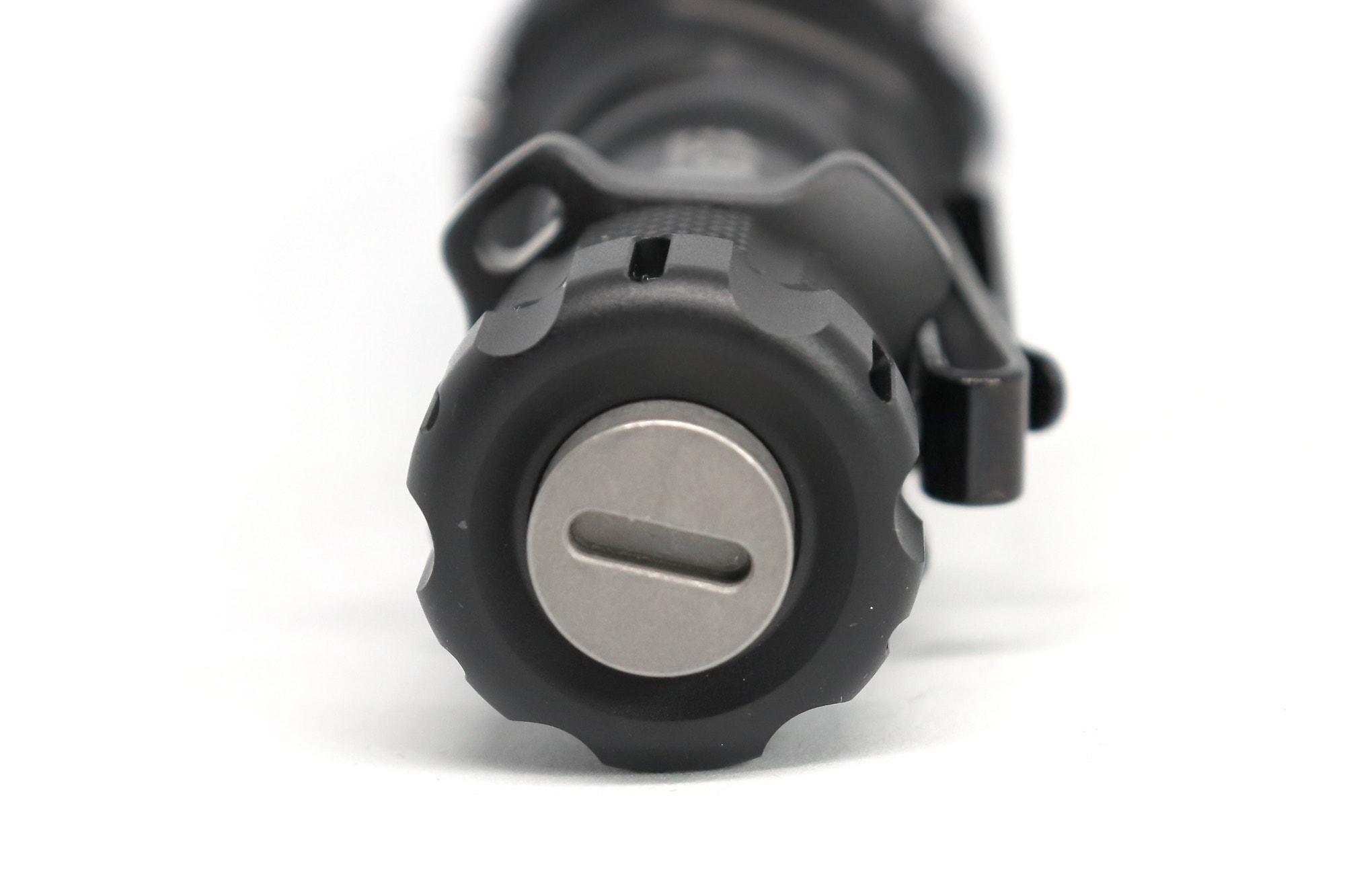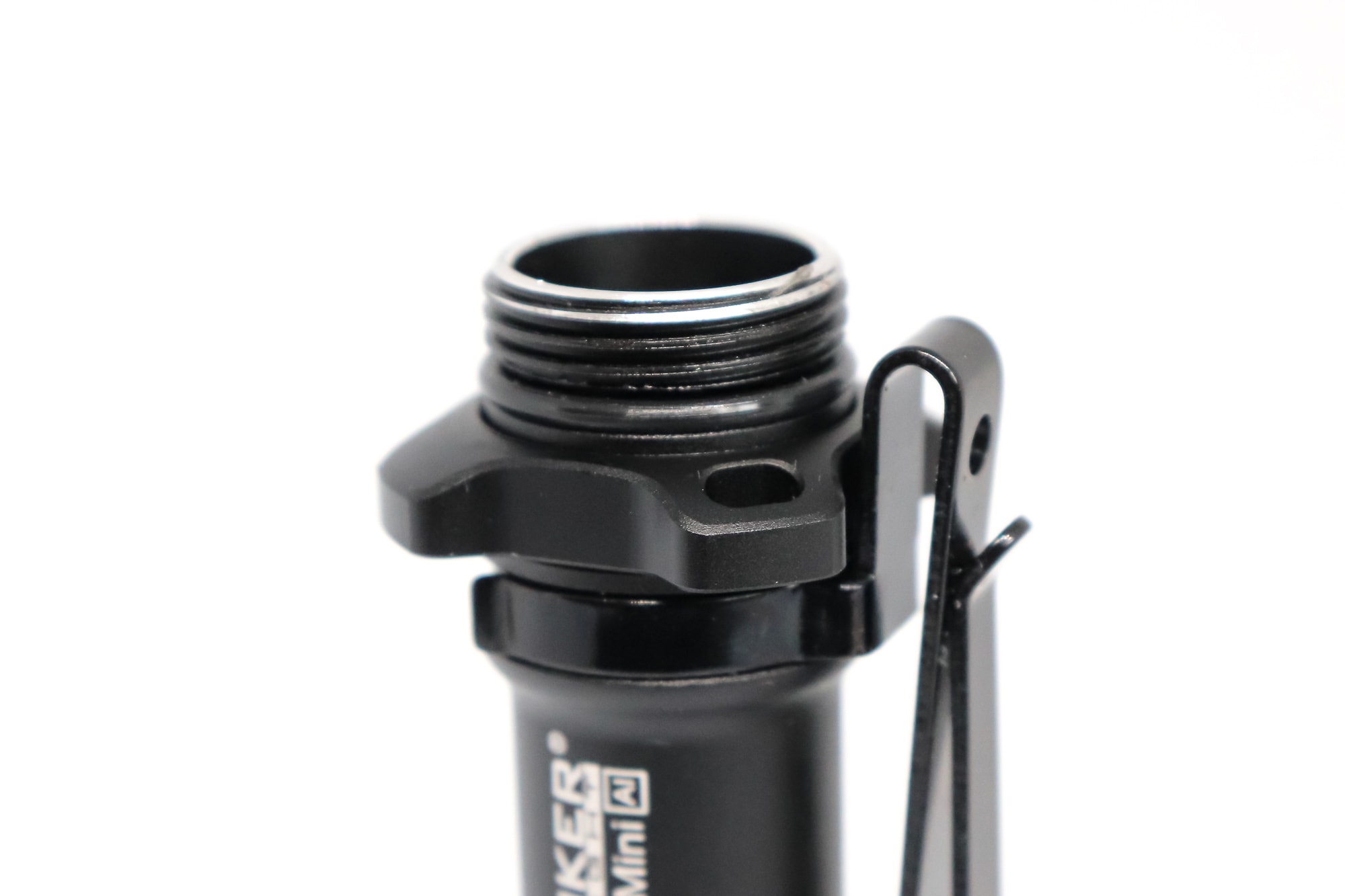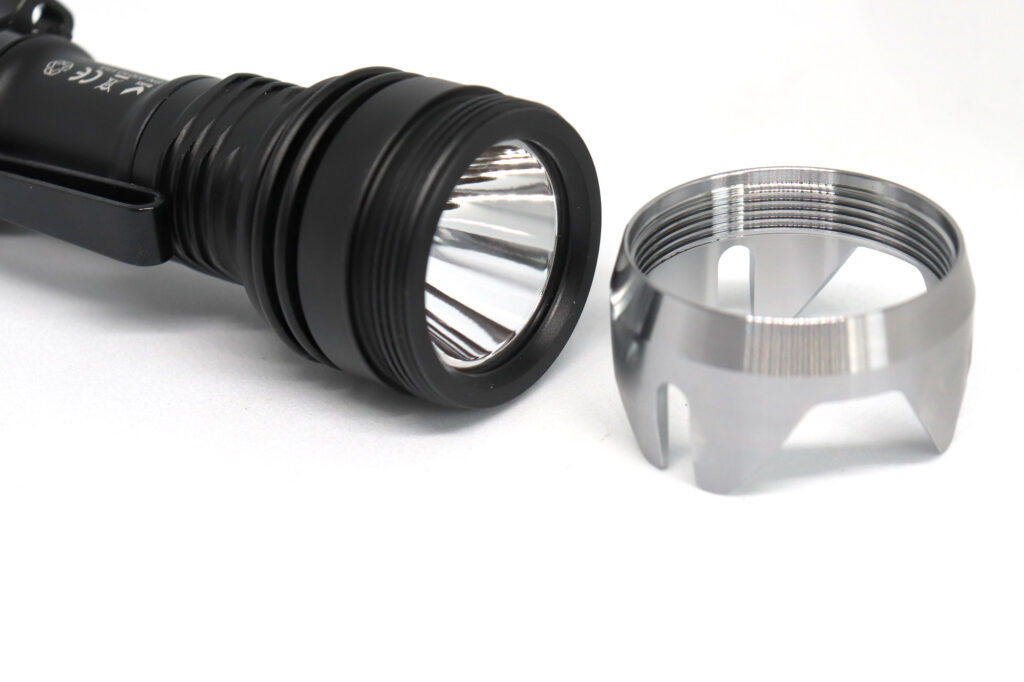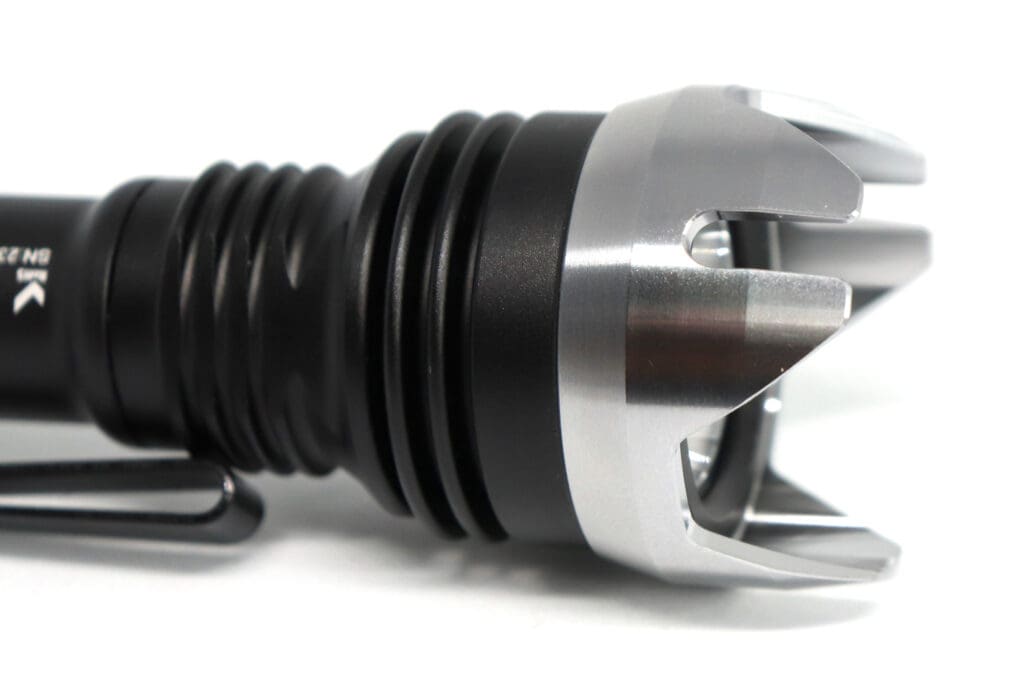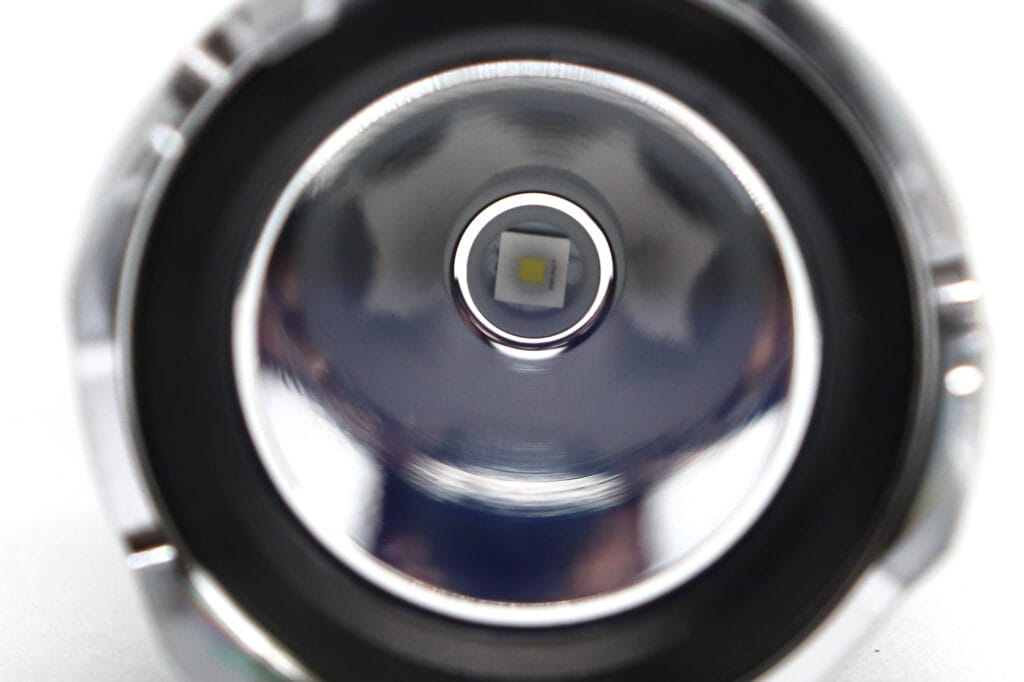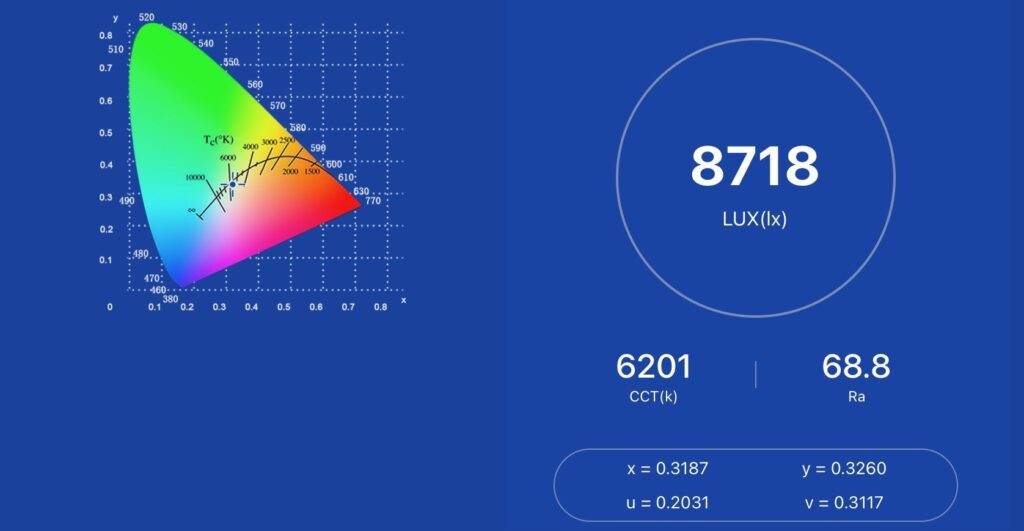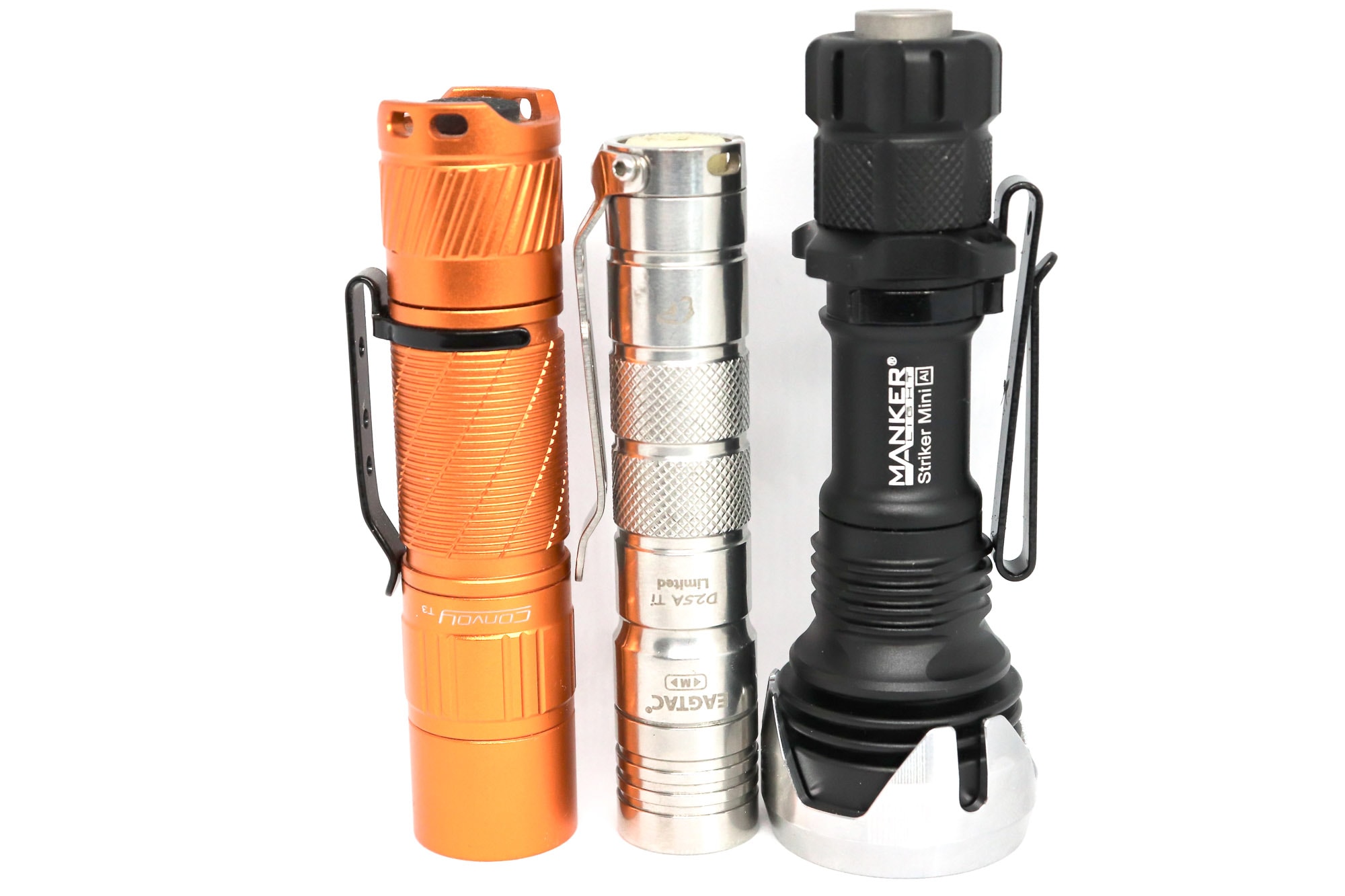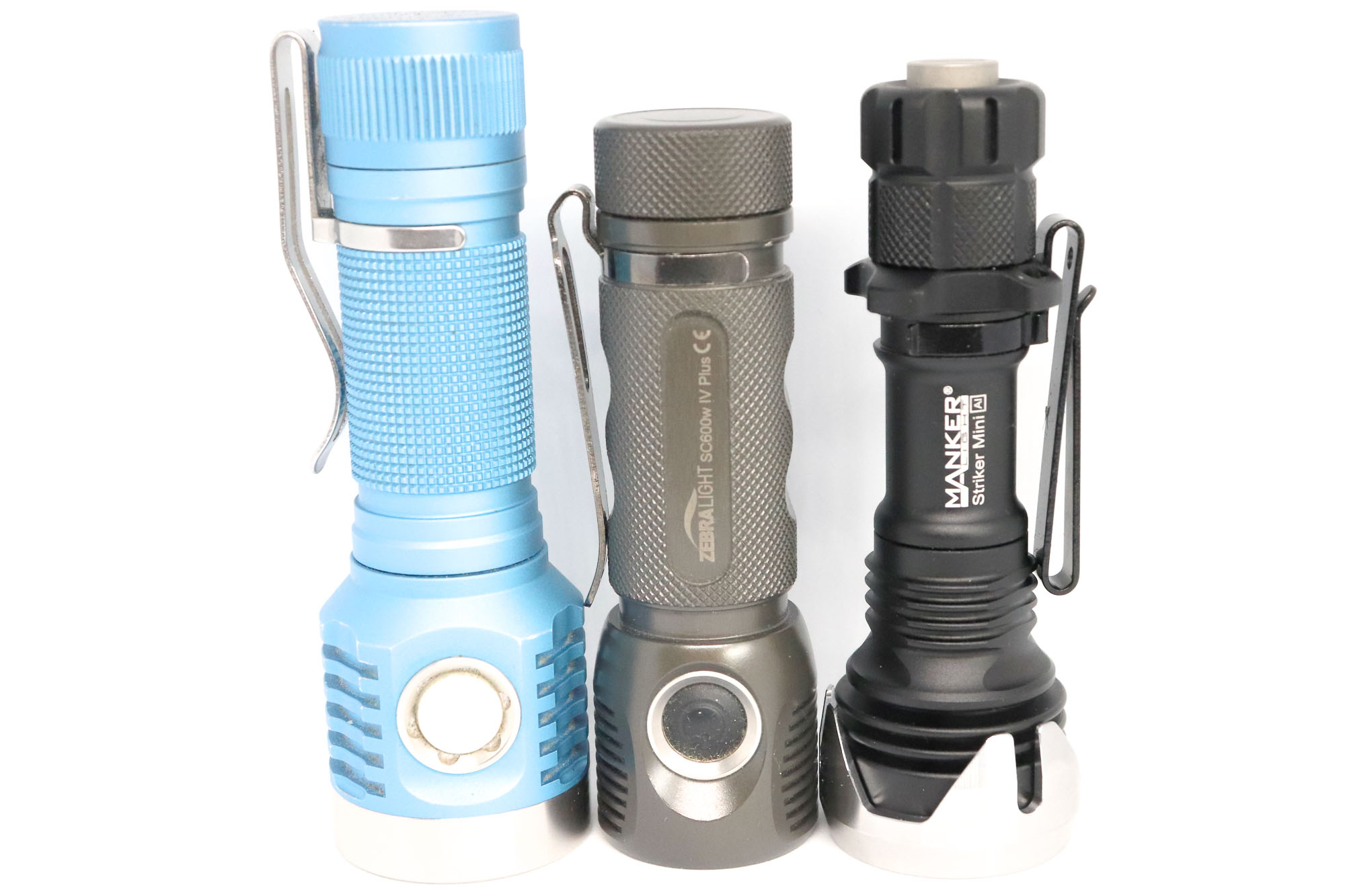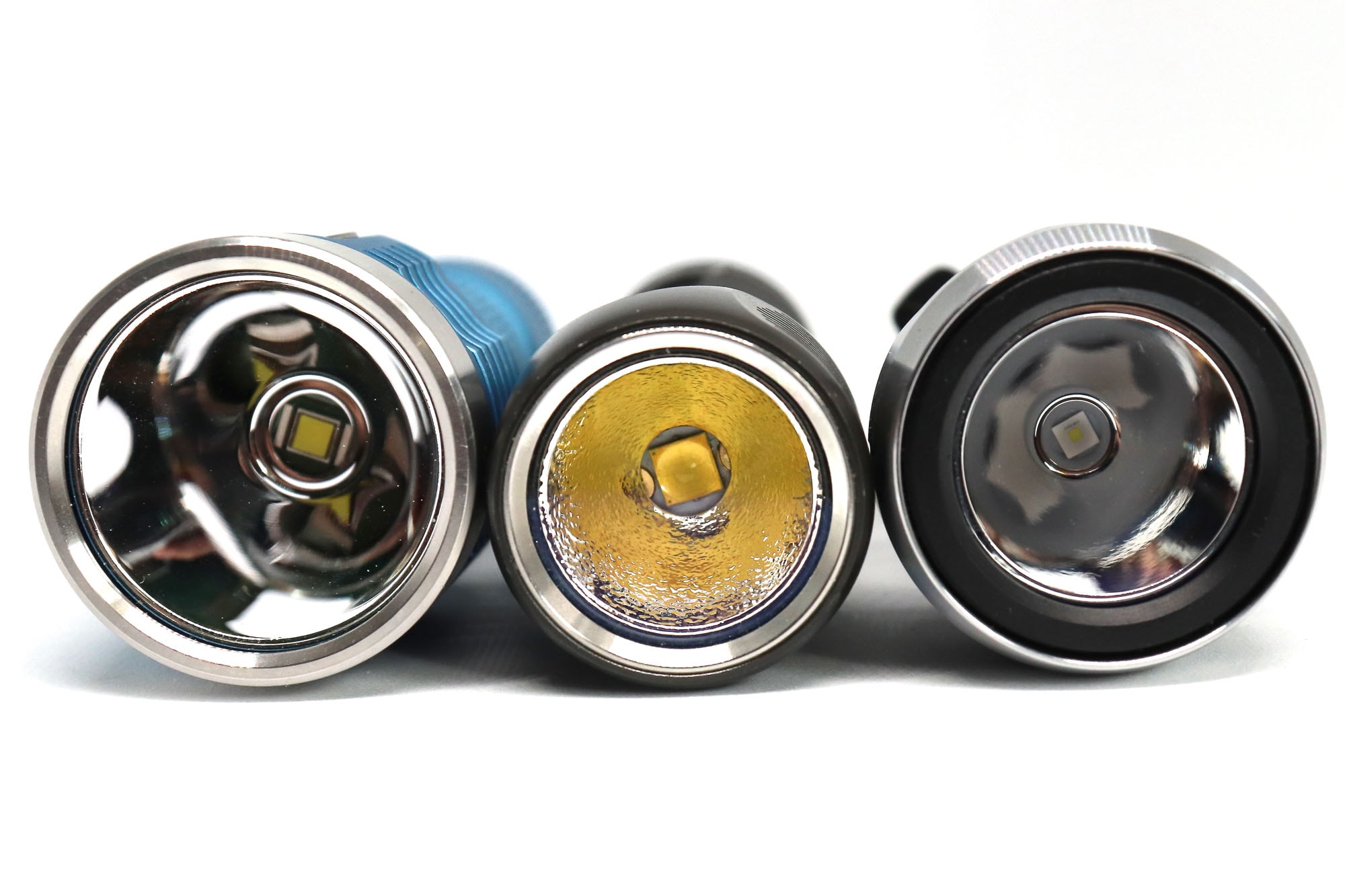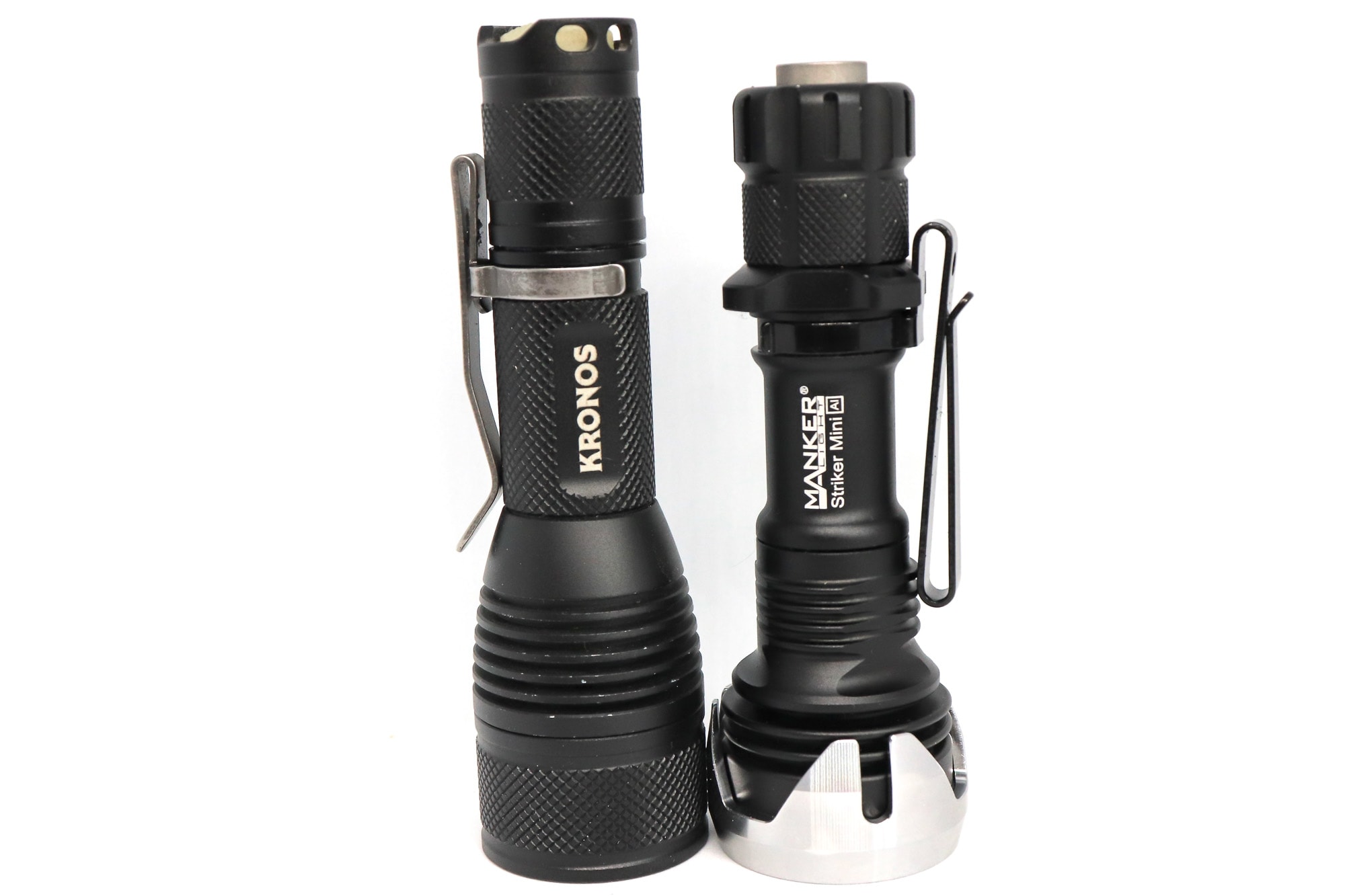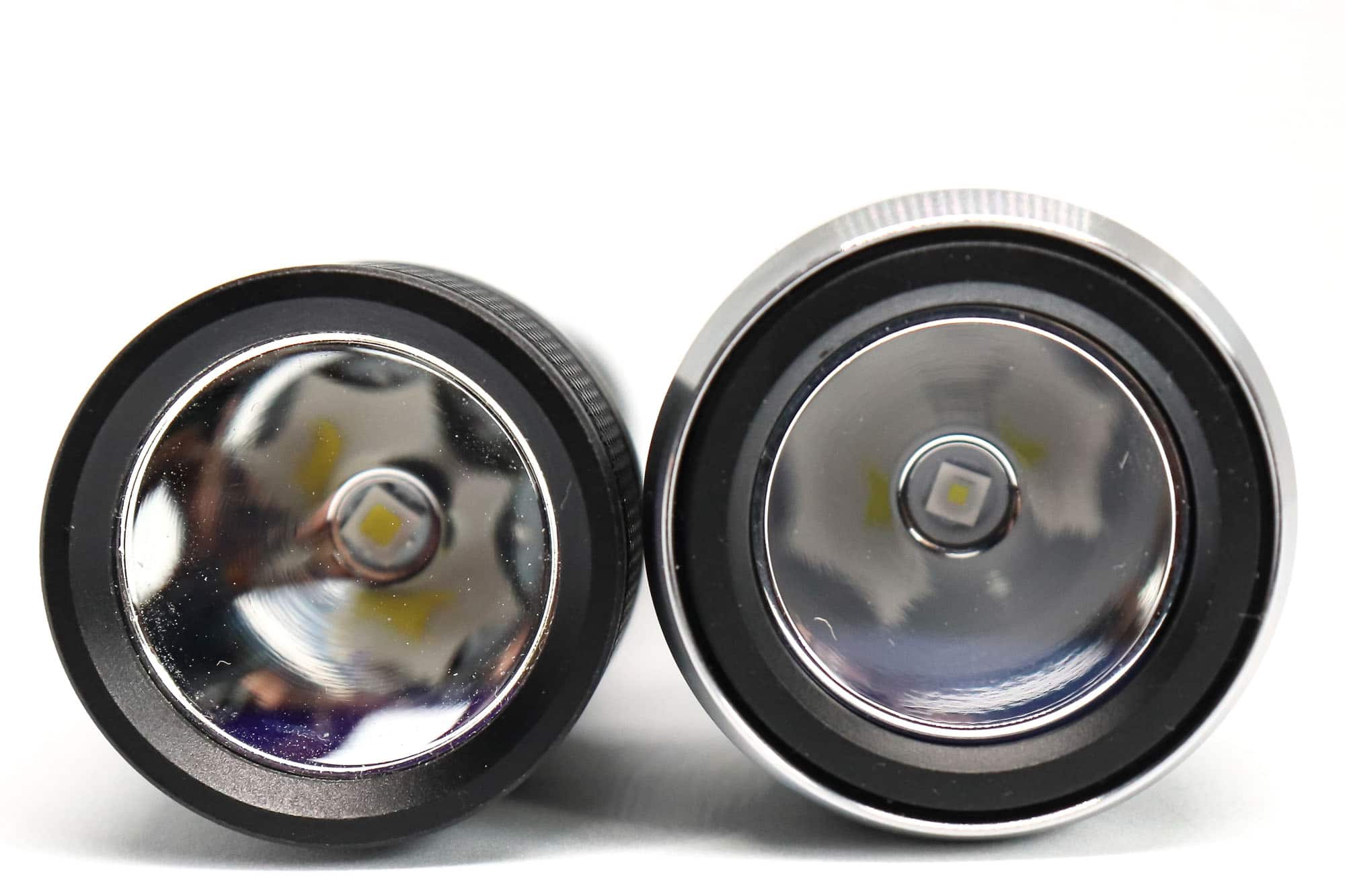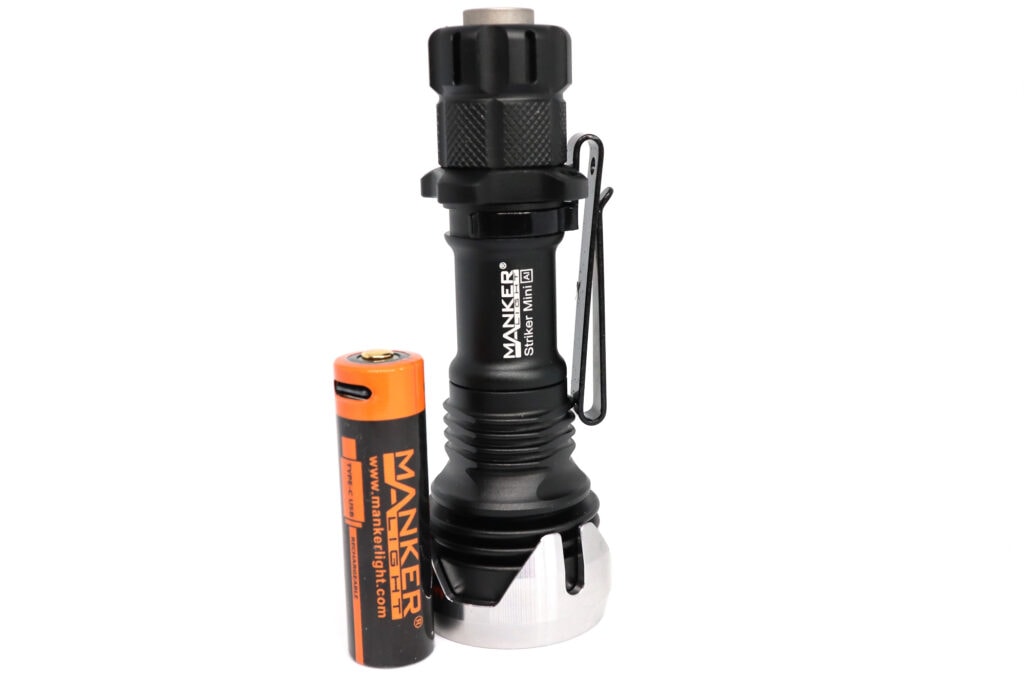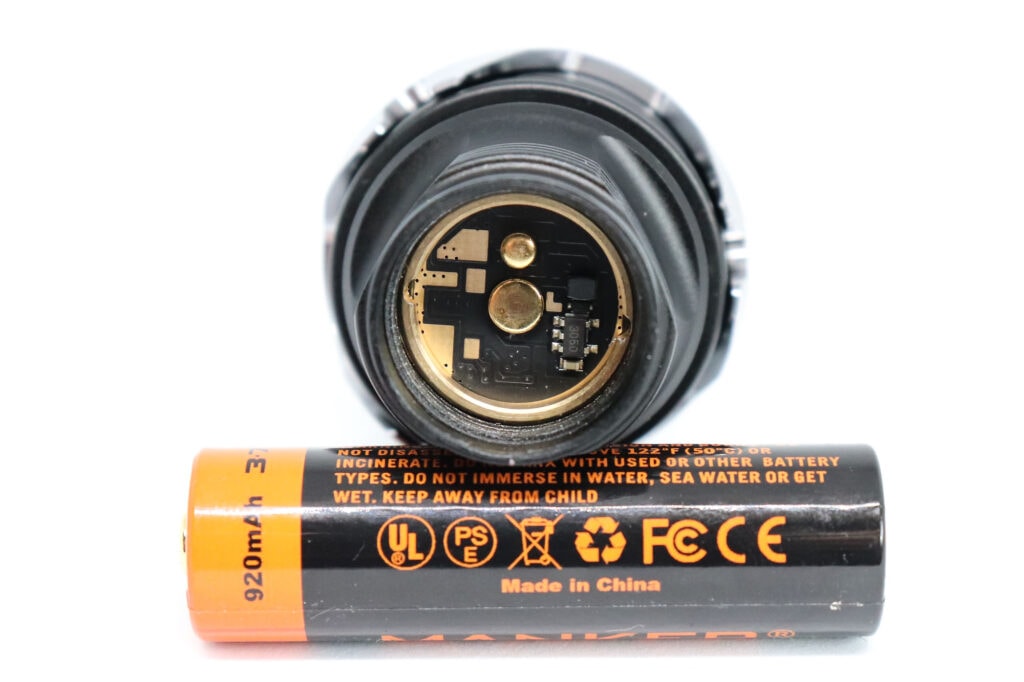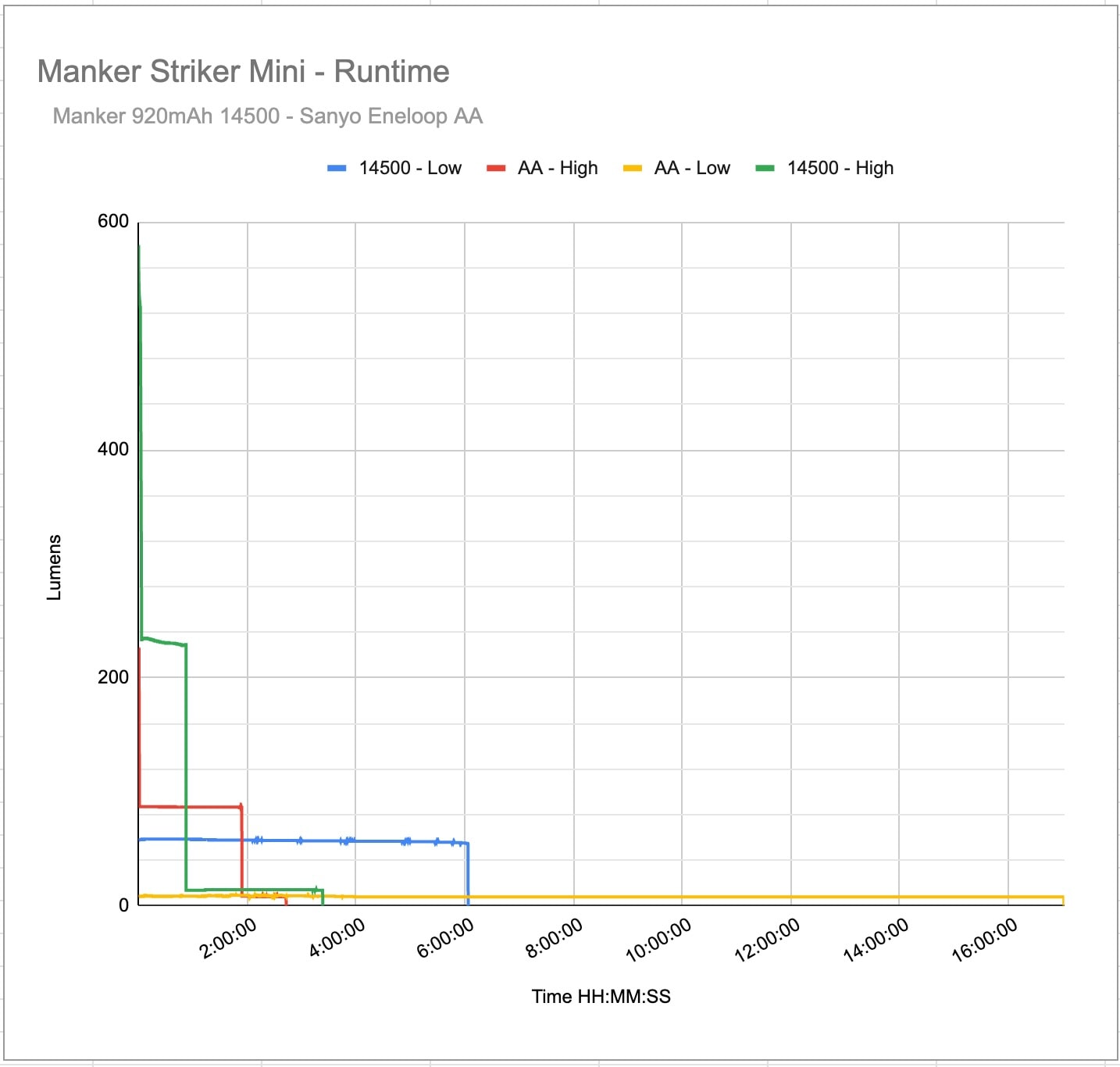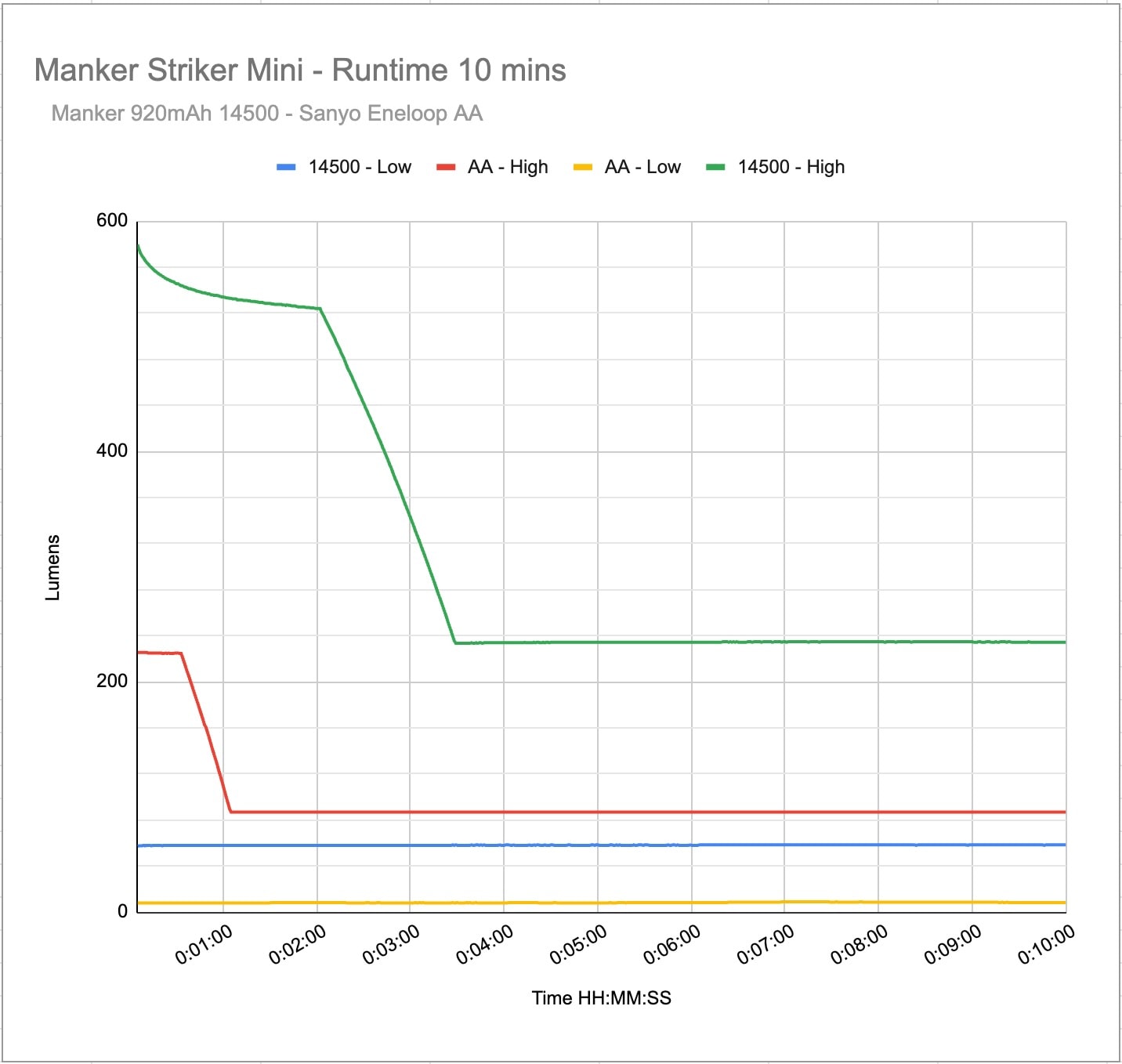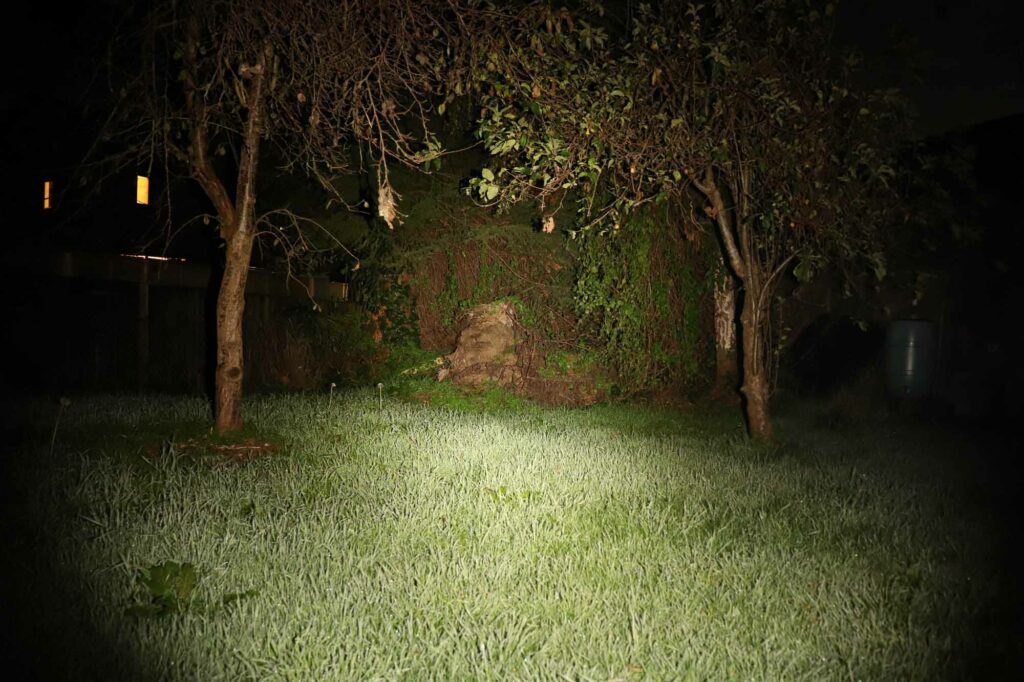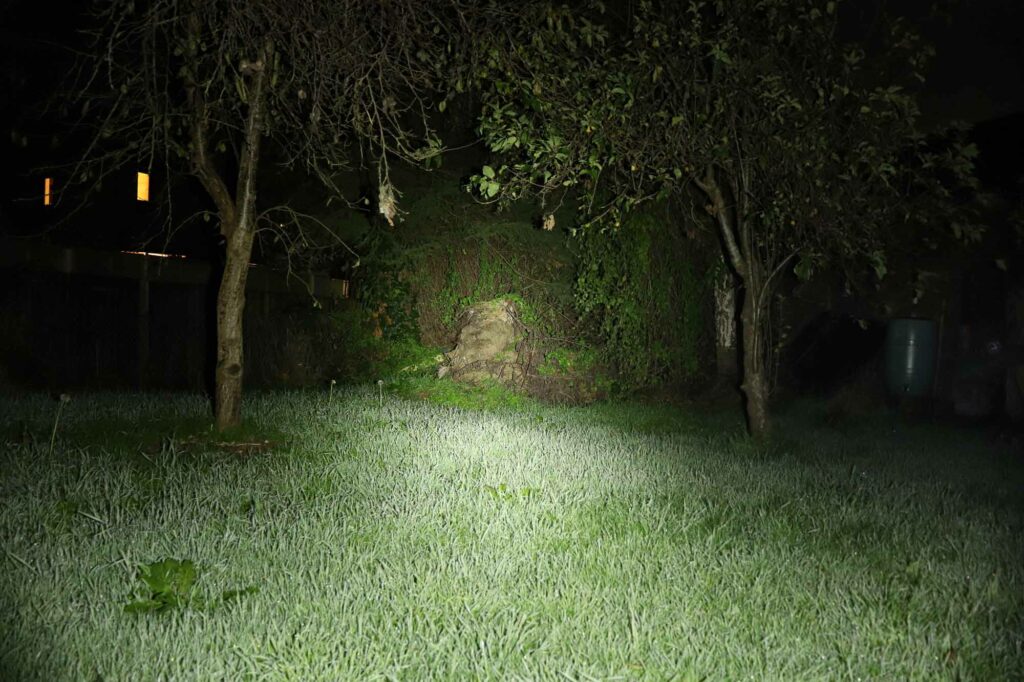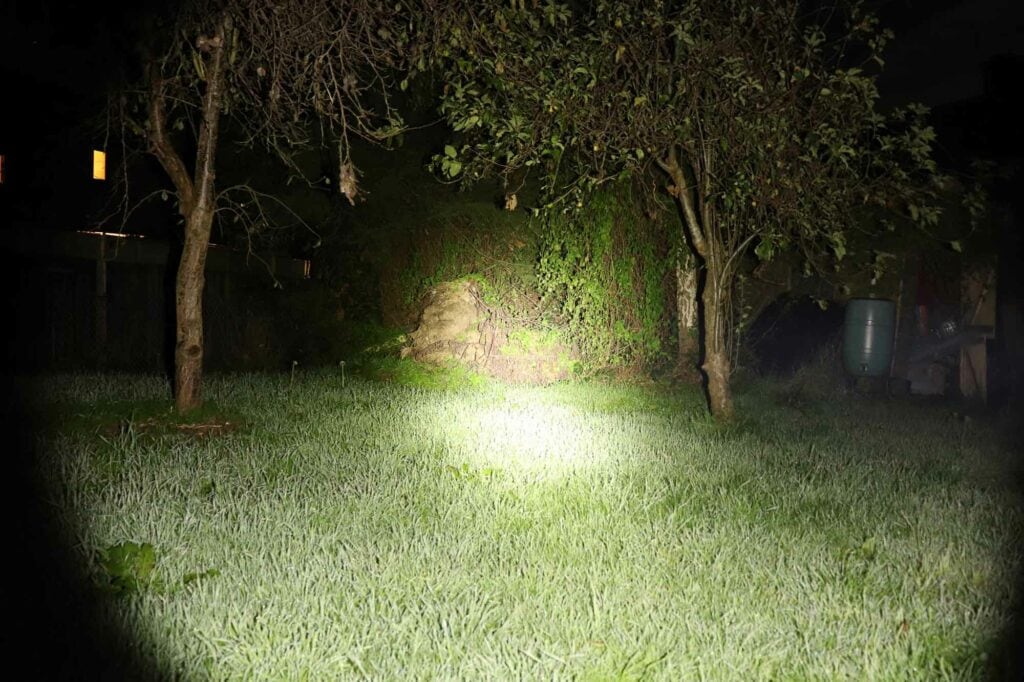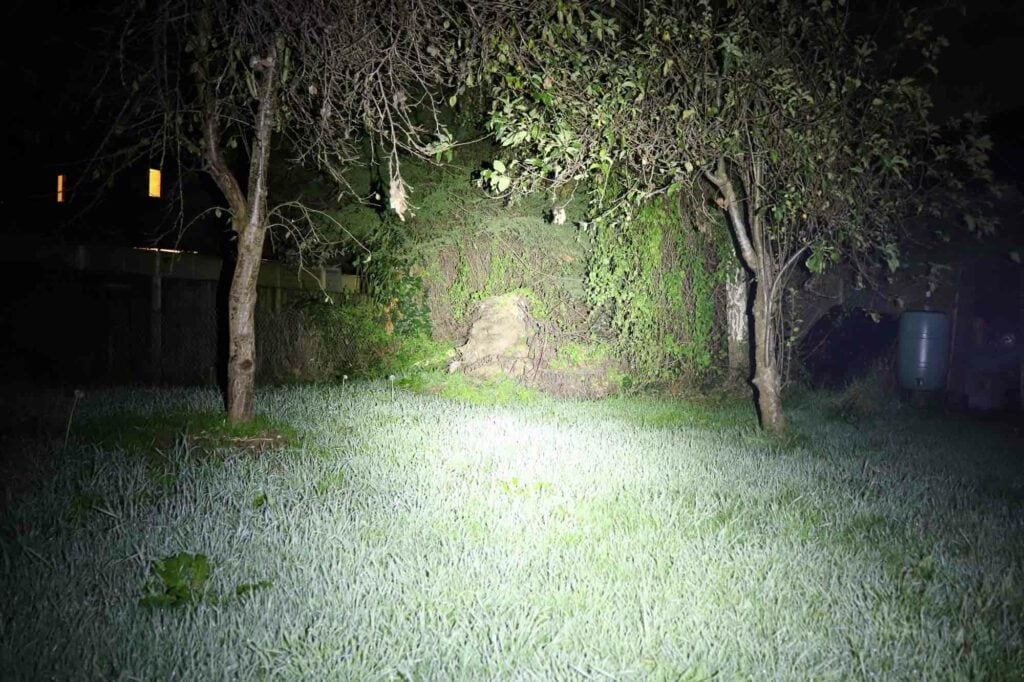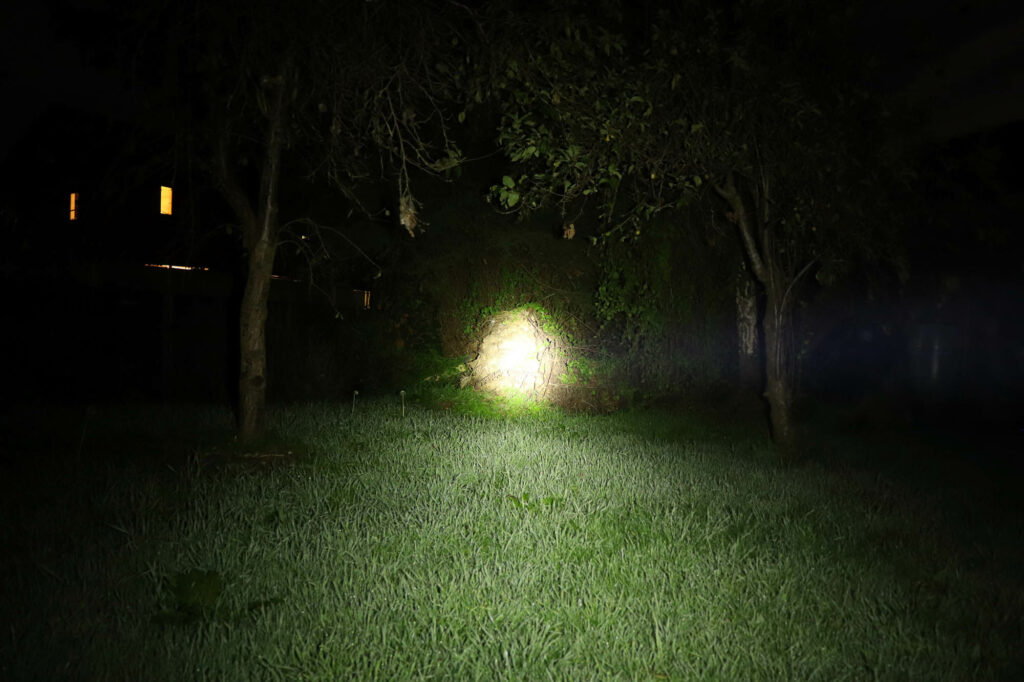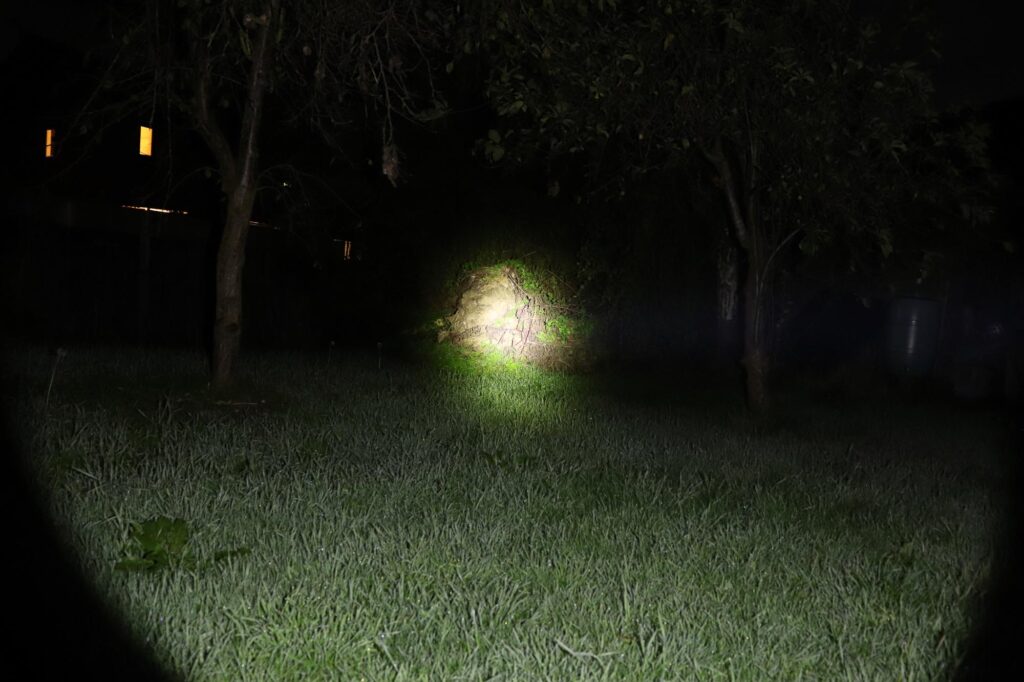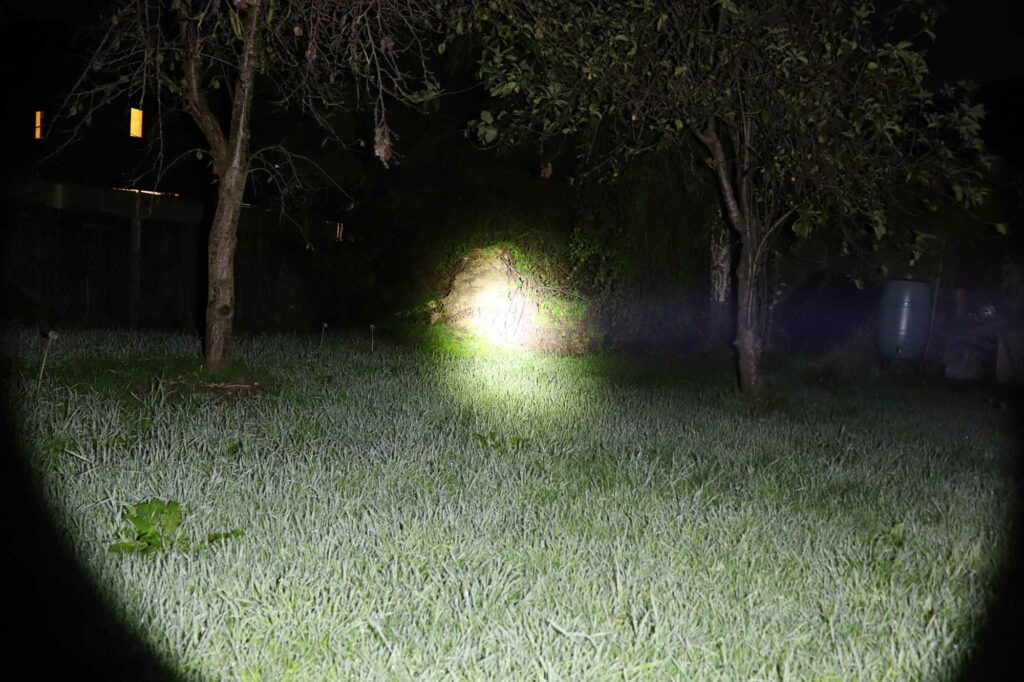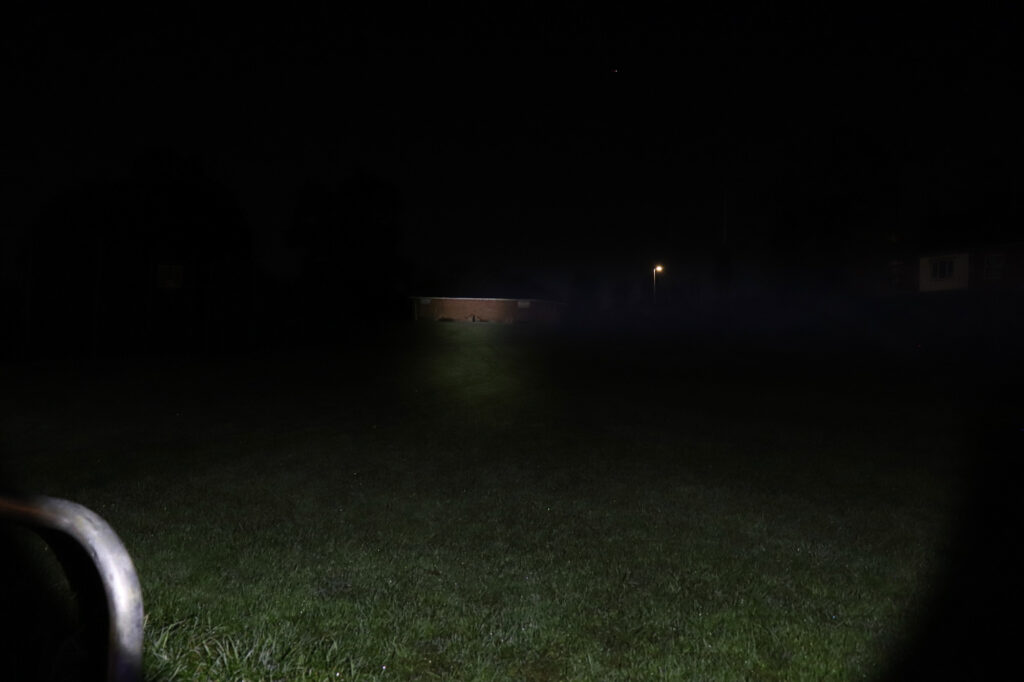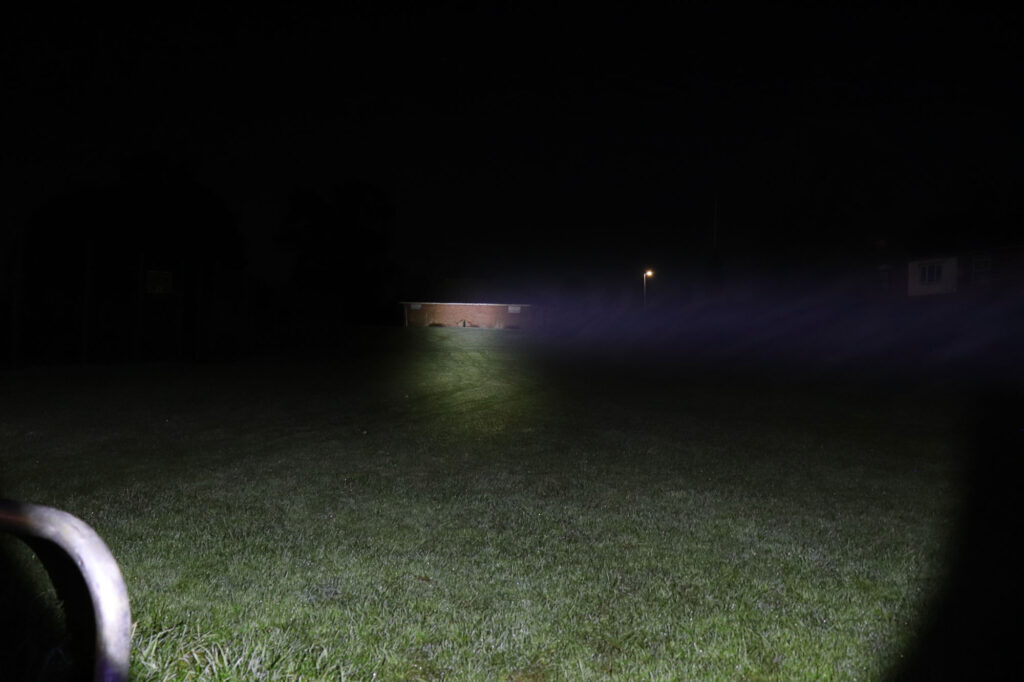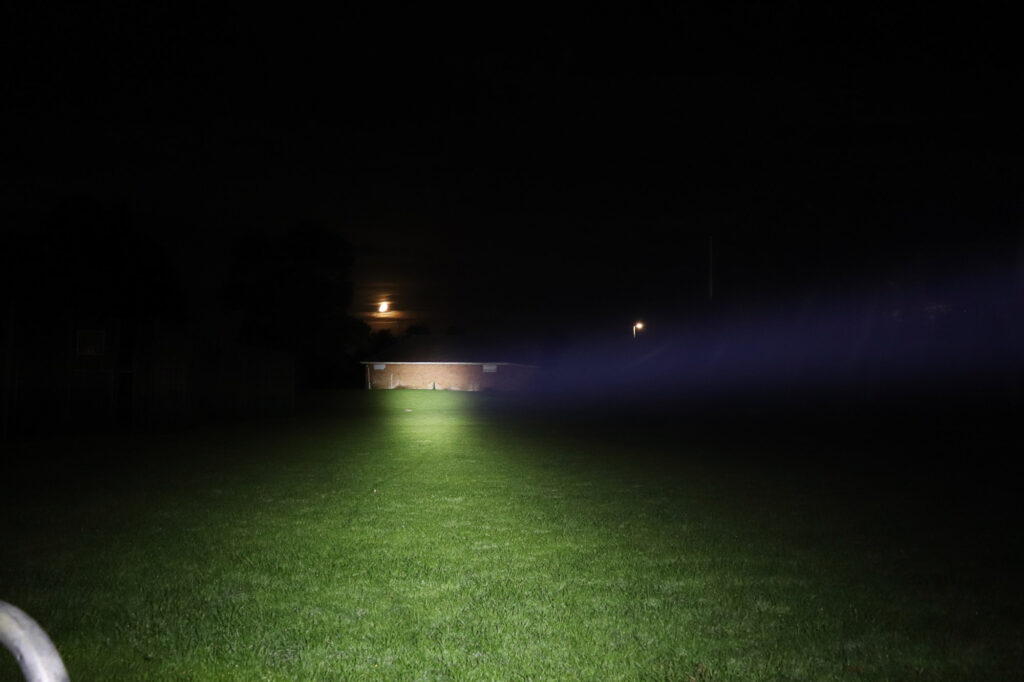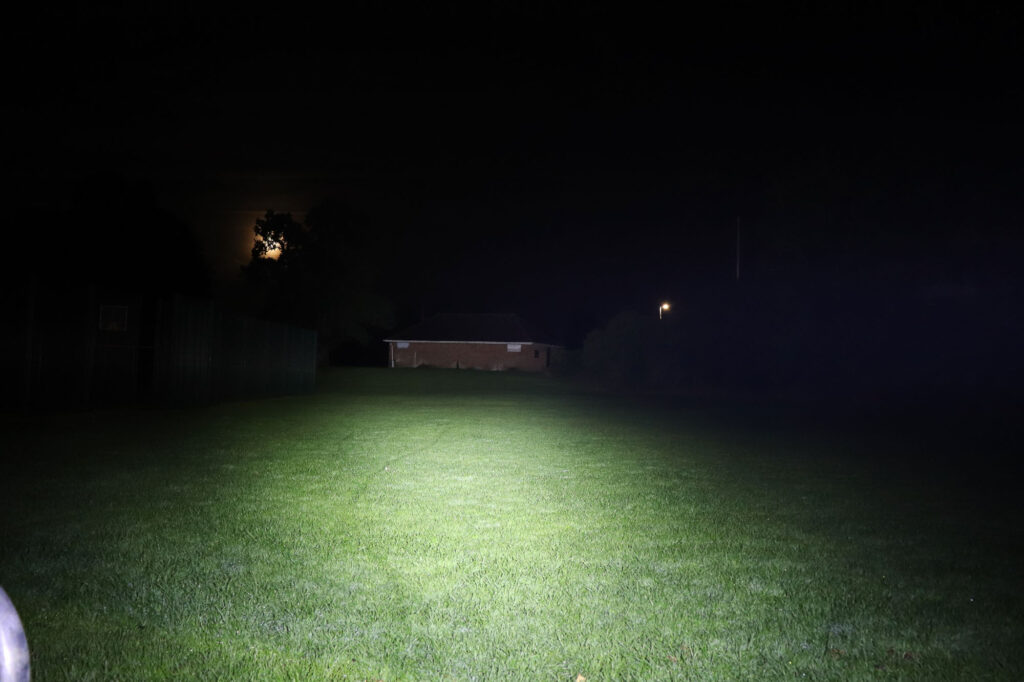1lumen selects and reviews products personally. We may earn affiliate commissions through our links, which help support our testing.
Manker Striker Mini review
Manker Striker Mini specs
| Brand & Model | Manker Striker Mini |
|---|---|
| Flashlight category | EDC, tactical flashlight |
| LED | Osram KW CSLNM1.TG |
| Max. output | 635 lumens |
| Max. beam distance | 430 meters |
| Max. beam intensity | 46,225 cd |
| Battery config. | 14500 / AA |
| Onboard charging | No |
| Main modes | H, L |
| Blinkies | Yes |
| Waterproof | IP68 |
| Review publication date | November 2023 |
Review intro:
The Manker Striker Mini is one of those lights that you see a picture and think, that is one I’d like to own. It looks so cool. It looks like a minturised 18650 thrower.
Manker offers the Striker Mini in two colours green or black. They both look great in the photos, although I have the blank one on test. The specs also look good for a 14500 light. Rather excited to see how this one performs.
Package quality.
The Manker Striker Mini comes in a very nice looking branded box which is designed specifically for this torch. As it has the model name and a line drawing of the light on it. Inside there is a foam insert holding the light safely in place. The box sadly doesn’t tell you anything in the way of technical information on the light or even what colour body it is.
The Striker Mini comes with several items
- Instruction pamflet
- Pocket clip (pre-installed)
- Manker branded 14500 battery with USB charging capability
- USB-C cable
- Manker branded wrist strap lanyard
- Glow in the dark plastic strips that you can fit to the slots on the Striker Mini
Flashlight in use, Build Quality, and Warranty
Manker have a very long list of what this light can be used for on their website. And I tend to agree, despite its styling, it could be a useful light from casual use, EDC, camping or more demanding tasks. The UI is certainly capable of this being used in a more tactical fashion. Although I’m not convinced a 14500 light would be the ideal choice for this due to the relatively low runtimes.
The Striker Mini has big styling. It looks like it could be a much larger light that has been minturised. Which I think is really rather the main appeal here. It also has a large reflector for a 14500 light. This makes it very cool and desirable to own. But ultimately comes at the compromise of runtime and potential performance.
For EDC use the light is actually quite chunky and while the body is thinner, its overall bulk is similar to a number of 18650 lights I own. There is no knurling on the body, but the compact design with lots of fins, a removable mini cigar grip, pocket clip and chunky tailcap mean it is very grippy in the hand. Almost to the point of being a big lumpy bumpy to hold. But never uncomfortable. The edges of the cigar grip are reasonably sharp, not cutting sharp. but on bare hands you know they aren’t rounded edges. The cigar grip, while being removable is essential if you want to use the cigar hold on the light.
The button is metal and has a good feel, although occasionally it can feel a little stiff and you may end up clicking it all the way on when you intended to only use the momentary function. Being a metal switch does mean it will tail stand. It isn’t the most stable when tail standing, but it works better than you might think it would.
You will also notice the switch has a slot in it and looking closely you can see six more slots around the tailcap. Manker did supply seven plastic glow in the dark strips that you could affix in these slots. However, my preference would be to source some tritium vials instead. The plastic glow in the dark strips are a nice idea, but don’t really do anything unless you shine a bright light at them to charge them up to glow for a short while afterwards.
The 2 way clip is pre-fitted to the Striker Mini, although I would say it is far too nose heavy to use the 2 way part of the clip.
At the other end of the light we find the stainless steel bezel. More on this in a bit, but ultimately it does make the Striker Mini prone to catching on things, should you wish to EDC in your jeans pocket or similar. It isn’t terrible, but something worth noting.
This is what Manker has about warranties on their website:
Mankerlight provide high-end products and intimate 5 Years warranty service to dealers and end users.
Warranty Details:
Mankerlight provides easy, reliable, speedy service to all lights under our warranty. Dealers will be responsible for customers.
1. Please contact the dealer for replacement if you experience any problem with Manker product within 15 days.
2. The dealer will offer free repairment service or replace the flashlight with the same or similar model if Mankerlight flashlight fails during normal use within a period of 5 years.
3. LEP flashlight, rechargeable battery, flashlight with built-in battery are warranted for a period of one year (12 months) from date of purchase
LED, Lens, Bezel, Beam, and Reflector
Ok, let’s address the elephant in the room. The bezel. It is frankly quite ridiculous. And despite the namesake of the light, it almost ruins it as something viable to buy. Fortunately the bezel is reversible, which really does save this light from complete mockery.
The bezel itself is made from stainless steel, it is silver on the black version of the Striker Mini and black on the green version. When fitted in the “strike” configuration it makes the light much longer, less stable head standing and completely ruins the beam. As well as making the light look rather ugly too. The bezel is also quite sharp, the edges are profiled like a single edge blade. If I’m being honest I really truly detest bezels like this and I’m unsure who they are really aimed at.
Even taking into consideration that the light is marked as a tactical flashlight. I do not see any benefit of the bezel. The light is too small to really use as a weapon and due to the cigar grip and pocket clip, should you strike anything, you are more likely to end up ripping your own hand up as much as anything else.
However, we can ignore all this silliness by inverting the bezel. It screws on and off effortlessly. When inverted it is still rather silly, but at least you can ignore it. The edges are still quite sharp, but much less so. It would have been great had Manker also included a plain bezel in the box. But at least it can be reversed and mostly ignored.
There is also an anti-reflective coated lens and a smooth (SMO) aluminum reflector. The reflector is quite large for a typical 14500/AA light. Although the head is quite chunky still given the reflector size, you can see a deep edge between the reflector and the stainless steel bezel. There are also lots of fins for cooling and I suspect for styling. They do look good.
The LED itself is an Osram unit that has no dome and a very small dye. These LEDs are generally very good for throw and the Striker Mini doesn’t disappoint in this regard.
The beam is very nice on the Stiker Mini, a large spill beam with an intense hotspot and a mild corona around the hot spot. The beam is clearly designed for distance, but it is a beam profile that is likely to please many. The Osram LED isn’t known for its CRI or tint as a rule. However, I do confess I quite like beam these LEDs produce. It is a rather cool beam, but to my eyes it looks very white rather than blue or green. Making it pleasant to use indoors or outside.
Below are the stats from my Opple Light meter, although I think the numbers do the beam a misjustice. I would happily use this LED with no real concerns or complaints.
Spectral measurements:
I used an Opple Light Master to measure the flashlight at 3 meters distance.
| Mode: | CCT: | CRI Ra: | duv |
|---|---|---|---|
| High | 6201 K | 68.8 | -0.0014 |
Dimensions and its competition
Dimensions:
| Manker Striker Mini | Millimeters | Inches |
|---|---|---|
| Length | 102 – 114mm | 4.01 – 4.48 in |
| Head diameter | 35mm | 1.37 in |
| Body diameter | 16.8mm | 0.66 in |
Dimensions are rounded to the nearest millimeter, and to the nearest tenth of an Inch.
Weight:
| Manker Striker Mini | Weight in grams | Weight in oz |
|---|---|---|
| Without battery: | 81.6g | 2.9 oz |
| With battery | 102.6g | 3.6 oz |
Weight is rounded to the nearest gram, and to the nearest tenth of an Oz.
Flashlight size comparison with its competition:
Group 1: Convoy T3, EagleTac D25A Ti Limited, Manker Striker Mini
Group 2: Emisar D1, Zebralight SC600w IV Plus, Manker Striker Mini
Group 3: Kronos X5, Manker Sterker Mini
Manker Striker Mini UI: User Interface and Driver
Available modes:
- High, Low
Available blinky modes:
- Strobe
From OFF:
- Press and hold: High (Momentary)
- Press and hold again (within 2 sec): Low (Momentary)
- Single click: On (in whichever mode you pre-selected)
- 3 fast clicks: Strobe
From ON:
- 1 click: Off
Mode memory:
- No
Shortcuts:
- None
Low voltage warning/protection:
- Light shuts off
Strobe/blinkies
- Strobe
Lock-out mode:
- Physical lockout via tailcap
PWM
- None that I can detect
Additional/summary info on the UI:
- Nice simple UI which is easy to use and doesn’t annoy you. Forward clicky button is firm, but has a good feel and is ideal for momentary use.
- Mode spacing might not suit everyone, with only 2 outputs it keeps it simple. The Low on a 14500 is still quite bright with lots of throw, allowing you to keep High for when you need the extra output. On an AA High is pretty good still, but low is now very low and with the concentrated beam only a few notches up from being a Moonlight.
Manker Striker Mini Charging and batteries
The Striker Mini doesn’t have any onboard charging facility, however the supplied Manker 14500 battery does have a USB-C charging port on it. Which can be charged from any USB outlet using the provided cable.
The 14500 has a red and green light to indicate the charging state.
The Striker Mini will also happily run on a regular AA battery, however I would advise to only use a NiMh style rechargeable battery and to avoid the use of alkaline batteries due to the risks of leakage.
The design of the driver board means you will need to use a button top battery, a flat top looks like it could cause a short by contacting some components on the driver board.
| Charge type | Fits | No fit | Charge time |
|---|---|---|---|
| None | 14500 or AA button top | flat top | – |
Performance test
Lumen measurements
How Lumens are Measured: Understanding ANSI FL1 Standards How Lumens are Measured: Understanding ANSI FL1 Standards: The ANSI FL1 standards specify that output in lumens should be measured 30 seconds after turning on, as this is the standardized time for measuring brightness according to the industry standard. This is why we focus on this part in our measurements. The ANSI FL1 standards require an ambient temperature of 22 ± 3°C. We record the ambient the ambient temperature to identify potential reasons for any observed discrepancies.To test the performance I use a homemade integrated sphere for lumen testing using a dedicated light meter. I also use the CeillingBounce Android app for measuring throw and runtimes. Both are calibrated using a 1Lumen supplied calibration light.
I used the Manker branded 14500 battery for all testing and for AA I used a Sanyo Enelopp NiMh.
Overall I am impressed with the performance of the Striker Mini, it mostly matched the claimed figures for output and throw. Of note should be the discharge profiles showing a nice regulation pattern. Runtimes also seemed good given the powersource and very close to the claimed numbers.
| Mode | Amps at start | Specified | 0 sec. | 30 sec. | 10 min. |
|---|---|---|---|---|---|
| Low – 14500 | 0.14 | 50 | 58 | 58 | 60 |
| High – 14500 | 2.12 | 635 | 573 | 543 | 234 |
| Low – AA | 0.11 | 8 | 8 | 8 | 8 |
| High – AA | 2.97 | 265 | 225 | 225 | 87 |
Parasitic drain:
- None
Manker Striker Mini Battery Life: Runtime graphs
How Runtimes are Measured: Understanding ANSI FL1 Standards About ANSI FL1 runtime standards: The runtime is measured until the light drops to 10% of its initial output (30 seconds after turning on). This does not mean that the flashlight is not usable anymore. The last column shows how long the light actually works till it shuts off. If there is a + symbol, it means that the test was stopped at that particular point, but the light was actually still running. This happens on certain occasions, with certain drivers, firmware, or batteries.| Mode | Specified runtime | Measured runtime ANSI | Time till shut off |
|---|---|---|---|
| Low – 14500 | 6h 35min | 6h 4min | 6h 4min |
| High – 14500 | 1h 58min | 3h 23min | 3h 23min |
| Low – AA | 30h | 17h 2min | 17h 2min |
| High – AA | 2h 33min | 1h 54min | 2hr 43min |
Peak beam intensity and beam distance measurements
About Peak beam intensity: Understanding ANSI FL1 Standards About peak beam intensity The calculated value of distance in meters at which the flashlight produces a light intensity of 0.25 lux. (0.25 lux is about the brightness of a full moon shining on an object). This means that the intensity has decreased so much, it becomes difficult to see darker objects, or objects that don’t reflect light. The columns ‘Meters’ and ‘Yards’ use rounded numbers.| Mode | Specs | Candela measured | Meters | Yards |
|---|---|---|---|---|
| Low – 14500 | 4,225 | 5,453 | 148 m | 162 yd |
| High – 14500 | 46,225 | 48,219 | 439 m | 480 yd |
| Low – AA | 900 | 785 | 56 m | 61 yd |
| High – AA | 17,556 | 18,244cd | 270 m | 295 yd |
Beamshots
- Camera: Canon EOS 200D DSLR
- Lens: Canon 18-55mm EFS IS used at 18mm
- Shutter: ¼
- Aperture: F4.5
- ISO: 1600
- White Balance: 5200k
To take the photos the camera and torch are both mounted to a tripod using a timer on the shutter. Beam shots are taken at three different distances.
Distance: 100m to the building
Distance: 5m to the tree on the left and 11m to the compost heap
Beamshots of the following flashlights compared at 5-10m:
- Convoy T3 Nichia 519a14500
- EagleTac D25A Ti Limited XP-L HI 14500
- Wurkkos TD02 SST-40
- Kronos X5 XP-L HI 14500
- Lumintop AD01 Osram W1 3xAA
Beamshots of the following flashlights compared at 100m:
- Wurkkos TD02 SST-40
- Kronos X5 XP-L HI 14500
- Lumintop AD01 Osram W1 3xAA
Please note that beamshots are mainly intended to showcase the beam pattern and beam quality, rather than overall performance. These images are typically taken directly after activation, and do not fully represent its overall performance. For accurate performance metrics, such as output, beam distance, and runtimes, you need to look at the performance section of this review.
Disclaimer: This flashlight was sent to us for review at no cost by Flashlight GO. We have not been paid to review, nor have we been holding back on problems or defects.
Final Verdict
Pros
- Awesome styling
- Fun light
- Performance
- Beam
- UI
Cons
- Silly bezel
- 14500 runtimes
Explanation on star ratings:
1: Avoid: a match would be a better choice – 2: Poor: significant defect or issues; almost unusable – 3: Average: some defects or issues; but still usable 4: Good: recommended (minor issues) – 5: Great: highly recommended
5 stars: ★★★★★
While our star rating provides a reliable indicator, we encourage you to read the full review to make an informed decision based on your own needs and preferences.
The Manker Striker Mini is an exceeding cool light that also delivers big performance and capability in something that ultimately is highly usable. This makes the Striker Mini an easy five star light. I still think the bezel is rather silly and would be an improvement with a plain bezel option, but despite this it doesn’t detract from the things the Striker Mini does well. I also highly appreciate good regulation on all output modes and power sources and a user interface that doesn’t irritate me to use it. I would and have been happy to EDC the Striker Mini and it will certainly be a keeper with regular use from now on.
Buy your Manker Striker Mini with a discount
Get 10% off at FlashlightGO, by using our exclusive 1lumen discount code: 1lumen
1lumen selects and reviews products personally. We may earn affiliate commissions through our links, which help support our testing.
